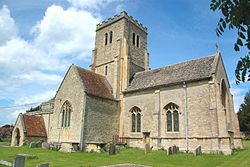Cuddesdon
| Cuddesdon | |
| Oxfordshire | |
|---|---|
 Church of All Saints, Cuddesdon | |
| Location | |
| Grid reference: | SP600030 |
| Location: | 51°43’23"N, 1°7’59"W |
| Data | |
| Population: | 502 (2001, with Denton) |
| Post town: | Oxford |
| Postcode: | OX44 |
| Dialling code: | 01865 |
| Local Government | |
| Council: | South Oxfordshire |
| Parliamentary constituency: |
Henley |
| Website: | cuddesdonanddenton.org |
Cuddesdon is a mainly rural village in Oxfordshire, five ana a half miles east of Oxford. It has the largest Church of England clergy training centre, Ripon College Cuddesdon. Residents number approximately 430 in Cuddesdon's nucleated village centre and about 70 in the hamlets of Denton and Chippinghurst.
The name 'Cuddesdon' is from the Old English Cuddes Dune meaning "Cudde's Hill" or the "Cuthwine's Hill".
The parish is bounded by the River Thame to the east and southeast, its tributary Cuddesdon Brook to the north.
Contents
History
Cuddesdon was an Anglo-Saxon linear village along in what is now the High Street, but since the 19th-century Church of England additions on the northern edge of the village and 20th-century residential developments (principally Bishop's Wood and Parkside), it has become a nuclear settlement centred on The Green. Since the 1950s many facilities and businesses in Cuddesdon, have closed, and most have been converted into housing. These include the petrol station, the shop, the school, the mill, the second public house and various farm buildings. In this way, the village has turned into a dormitory village.
Church
The parish church is All Saints.
Abingdon Abbey founded the Church parish church here in about 1180.[1] All Saints' parish belongs to the Diocese of Oxford.
Bishop's palace
- Main article: Cuddesdon Palace
Cuddesdon Palace was completed by 1634 for John Bancroft, who was Bishop of Oxford from 1632 until 1641.[2] In 1644 during the Civil War Royalist forces burned the palace to render it unusable by the Parliamentarian forces besieging Oxford.[2] In 1676 John Fell was made Bishop of Oxford and in 1679 he commissioned the complete rebuilding of the palace.[2] In 1846 Bishop Samuel Wilberforce had the chapel of Saints Peter and Paul added to the Palace.[2] It was designed by the Gothic Revival architect Benjamin Ferrey.[2] Successive Bishops of Oxford resided at the palace until Thomas Banks Strong retired in 1937.[2]
For the duration of the Second World War, the Commissioners of Queen Anne's Bounty were evacuated from London and occupied the palace.[2] Thereafter, The Society of the Salutation of Mary the Virgin occupied the palace from 1946 until 1949.[2] In the 1960s the palace was in private use for a few years, but it burnt down before the end of that decade. The bishop's chapel escaped the fire and survives today.[3]
Theological college
In 1854 Bishop Wilberforce founded Cuddesdon College on land opposite the Palace to train men to become Anglican clergy. In 1975 the college merged with Ripon Hall to form Ripon College Cuddesdon. Due to the extent of past and present church connections, the village is also known as the "Holy Hill". It has been suggested that in Cuddesdon "the presence of the Church has been more strongly felt than perhaps anywhere else in England".[4]
See also
Outside links
| ("Wikimedia Commons" has material about Cuddesdon) |
References
- ↑ Sherwood & Pevsner 1974, p. 562.
- ↑ 2.0 2.1 2.2 2.3 2.4 2.5 2.6 2.7 Lobel 1957, pp. 96–116.
- ↑ Sherwood & Pevsner 1974, p. 563.
- ↑ Chapman 2004
- Chapman, Mark (2004). God's Holy Hill: A History of Christianity in Cuddesdon. Chipping Norton: The Wychwood Press. ISBN 1-902279-20-4.
- A History of the County of Oxford - Volume 5 pp 96–116: Bullingdon Hundred (Victoria County History)
- Nikolaus Pevsner: The Buildings of England: Oxfordshire, 1974 Penguin Books ISBN 978-0-300-09639-2